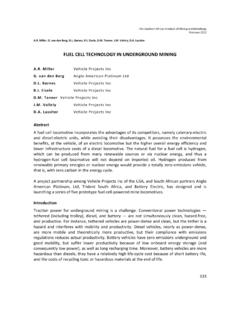Transcription of Appendix B: Electricity Sector Strategy Analysis
1 Appendix B: Electricity Sector Strategy Analysis INTRODUCTION. In this Appendix , we detail the analytical steps behind four key components, specifically: The forecasted thermal generating retirements in connecticut ;. The amount of Class I renewable energy required in 2020 for connecticut to meet its Renewable Portfolio Standard;. The technical potential and levelized costs of renewable resources in the New England region; and The costs and opportunity for cost reductions of solar photovoltaics. FORECASTING THERMAL GENERATOR RETIREMENTS. New England's current generating fleet is aging. DEEP estimates that 99% of connecticut 's nuclear, natural gas, and coal power capacity and 95% of capacity in Maine, Massachusetts, New Hampshire, Rhode Island, and Vermont will exceed average industry lifetimes by mid-century.
2 The forecasted operating thermal capacity in connecticut through 2050 is shown in Figure B-1. Figure B-1: Forecasted operating thermal capacity in connecticut The energy Information Administration lists 8,500 MW of thermal (nuclear, gas, coal, and oil) generating capacity operating today in connecticut . Assuming industry average lifetimes, nearly all of the nuclear, gas, and coal capacity will be retired by 2050. 10,000. 9,000. 8,000. 7,000. Nameplate capacity, MW. 6,000. Petroleum 5,000. Coal 4,000. Natural gas 3,000. 2,000. 1,000 Nuclear 0. 2015. 2017. 2018. 2019. 2021. 2025. 2027. 2028. 2029. 2031.
3 2035. 2037. 2038. 2039. 2041. 2045. 2047. 2048. 2049. 2012. 2013. 2014. 2016. 2020. 2022. 2023. 2024. 2026. 2030. 2032. 2033. 2034. 2036. 2040. 2042. 2043. 2044. 2046. 2050. year Analysis based on: EIA, Existing Generating Units; and Hodgkins, Wave of Retirements.. The primary input for this Analysis comes from the energy Information Administration's Form-860, Existing Generating Units in the United States by State and energy Source. 1 This table lists all existing 1. energy Information Administration (EIA), Existing Generating Units. Available at 2012 connecticut Comprehensive energy Strategy Draft for Public Comment Appendix B: Electricity Sector Strategy Analysis electrical generators in connecticut , along with their nameplate capacities (MW), fuel , operational status, and month and year of initial operation, from which DEEP determined the current age of each plant.
4 The second key input to this Analysis is the assumed retirement age of these plants. As reported in the trade journal SNL Power Daily, a 2012 Bernstein & Co. report calculated the average retirements ages of coal-fired, gas-fired (combustion turbines), and oil-fired plants to be 49, 40, and 41 years, DEEP used these assumed retirement ages for all fossil-fired power plants; for nuclear reactors, DEEP used the actual years when their current licenses will expire, ( , 2035 and 2045 for Millstone 2 and 3).3. Using the age of each plant and its expected retirement age (should it follow industry norms), a simple calculation gives the retirement year of each plant and the forecasted operating capacity in each year between now and 2050 (when the Analysis period ends).
5 However, not all the system operating capacity will necessarily run in any given year. For example, connecticut currently has 2,900 MW of oil-fired capacity listed as operational in form EIA-860, but generated only 408,000 MWh from oil-fired plants in This amounts to a fleet-wide 2% capacity factor, meaning that the vast majority of these oil- fired power plants are no longer running on any regular basis. This means that the actual operating lifetimes of connecticut 's oil-fired plants may be extended beyond those shown in Figure A-1, although these plants will likely continue to be far underutilized.
6 CLASS I RENEW ABLE energy REQUIRED TO MEE T RPS. connecticut 's Renewable Portfolio Standard (RPS), established in 1998, imposes annual requirements on the percentage of retail sales that must be generated from qualifying renewable resources. The terminal requirement is a 20% Class I renewable portfolio by 2020, although there are intermediate targets as The forecasted annual Electricity load for connecticut in 2020 in this Draft Strategy 's Expanded energy Efficiency scenario is 30,981 GWh. (For more details, see the Efficiency and Industry Technical Appendix ). Meeting the RPS with this load would require 6,196 GWh of Class I generation in 2020.
7 Because of differing capacity factors, generating this amount of renewable Electricity would require different nameplate capacities of wind, solar, or other renewables. The 2012 Integrated Resource Plan (IRP) assumed annual capacity factors of 13% for solar PV, for onshore utility-scale wind, and 37%. for offshore wind in With a 50/50 split between solar PV and wind (and assuming the wind 2. Hodgkins, Jay. Wave of Plant Retirements Likely Approaching; IPPs Particularly Exposed. SNL Power Daily, April 25, 2012. Available at http:// 3. Nuclear Regulatory Commission. NRC Renews Millstone Nuclear Power Station Operating Licenses for an Additional 20 Years.)
8 NRC News no. 05-161. Washington DC: Office of Public Affairs, 2005. Available at 4. energy Information Administration (EIA), Existing Generating Units. Data from Form EIA-860. Washington DC: energy Information Administration, 2010. 5. Conn. Gen. Stat. 16-245a. 6. connecticut Department of energy and Environmental Protection, 2012 Integrated Resource Plan for connecticut .. Available at 2. 2012 connecticut Comprehensive energy Strategy Draft for Public Comment Appendix B: Electricity Sector Strategy Analysis is half onshore, half offshore much of which will likely be accessed from outside the state), it would take GW of wind and GW of solar PV to generate 6,196 GWh/year.
9 These figures illustrate technical potential and are only provided for illustrative purposes. Itwould be highly unlikely that those levels of offshore or onshore wind could be sited or financed in the near term. Of course, many other resource mixes are possible. POTENTI AL AND COSTS OF NEW ENGLAND'S RENEWABLE. RESOURCES. Table 1 in Chapter 3 ( Electricity ) lists the technical potential of renewable resources in the New England region, as well as ranges of the levelized cost of energy from each resource with and without existing Federal subsidies. TECHNICAL POTENTIAL. For all resources listed in Table B-1 (solar, wind, biomass, small hydro, enhanced geothermal), the technical potential numbers are taken directly from a 2012 study from the National Renewable energy Laboratory (NREL).
10 7 This report estimated the state-by-state technical potential of these resources, both on a capacity (GW) and annual energy (GWh/year) basis. Technical potential is an estimate of the Electricity generation potential of a resource based on the availability and quality of the resource, technical performance of current systems, and constraints based on land topography and environmental or other uses. Technical potential does not include economic or market considerations, such as fuel or technology costs, the impacts of policy, or projected market uptake. Additionally, in nascent industries such as these, costs are extremely variable.


















